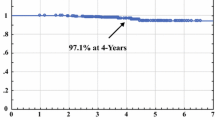Purpose:
To investigate the feasibility of applying exclusive intraoperative radiation therapy (IORT) after conservative surgery in limited-stage breast carcinoma and to evaluate late effects and cosmetic results after this new conservative treatment.
Patients and Methods:
From October 2000 to November 2002, 47 consecutive patients with unifocal breast carcinoma up to a diameter of 2 cm received conservative surgery followed by IORT with electrons as the sole adjuvant local therapy. Three different dose levels were used: 20 Gy (seven patients), 22 Gy (20 patients), and 24 Gy (20 patients). Patients were evaluated using RTOG/EORTC scale to assess the incidence of late complications. During follow-up, a radiologic assessment with mammography and sonography was periodically performed and any breast-imaging alterations were reported.
Results:
After a follow-up ranging from 36 to 63 months (median, 48 months), 15 patients developed breast fibrosis (grade 2 in 14 patients, grade 3 in one patient), two patients presented with grade 3 skin changes, one patient developed a clinically relevant fat necrosis, and one patient showed breast edema and pain. Two patients developed contralateral breast cancer and one distant metastases; no local relapses occurred. Asymptomatic findings of fat necrosis were observed at mammography in twelve patients (25.5%), while an hypoechoic area was revealed by sonography in ten patients (21.5%). In four patients (8%), mammographic and sonographic findings suggested malignant lesions and required a rebiopsy to confirm the benign nature of the lesion.
Conclusion:
IORT in breast carcinoma is still an experimental treatment option for select patients with breast cancer and its application should be restricted to prospective trials. Although preliminary data on local control are encouraging, a longer follow-up is needed to confirm the efficacy of IORT in breast cancer and to exclude that severe late complications compromise the cosmetic results or modify the radiologic breast appearance during follow-up increasing the need for additional investigations.
Ziel:
Untersuchung der Durchführbarkeit einer alleinigen intraoperativen Strahlentherapie (IORT) nach brusterhaltender Operation bei frühem Mammakarzinom sowie der Spättoxizität und des kosmetischen Ergebnisses dieser neuen konservativen Behandlungsmodalität.
Patienten und Methodik:
Von Oktober 2000 bis November 2002 erhielten 47 konsekutive Patientinnen mit unifokalem Mammakarzinom bis zu einem Durchmesser von 2 cm eine brusterhaltende Operation und eine anschließende alleinige IORT mit Elektronen. Drei unterschiedliche Dosisstufen wurden untersucht: 20 Gy (sieben Patientinnen), 22 Gy (20 Patientinnen) und 24 Gy (20 Patientinnen). Spätnebenwirkungen wurden anhand der RTOG/EORTC-Skala klassifiziert. Im Rahmen einer regelmäßigen Nachsorge wurden die Brustmorphologie in Mammographie und Ultraschall beurteilt und die Inzidenz von bildgebend festgestellten Brustveränderungen analysiert.
Ergebnisse:
Nach einem Untersuchungszeitraum von 36 bis 63 Monaten (median 48 Monate) entwickelten 15 Patientinnen in der mit alleiniger IORT behandelten Gruppe eine Brustfibrose (Grad 2 bei 14 Patientinnen, Grad 3 bei einer Patientin). Bei zwei Patientinnen traten Hautveränderungen Grad 3 auf, und bei einer Patientin wurde eine klinisch relevante Fettnekrose mit schmerzhaftem Brustödem beobachtet. Bei zwei Patientinnen wurde im Verlauf ein kontralaterales Mammakarzinom diagnostiziert, und eine Patientin entwickelte Fernmetastasen. Lokalrezidive wurden bisher nicht beobachtet. Asymptomatische Fettnekrosen wurden in der Mammographie bei zwölf Patientinnen (25,5%) diagnostiziert, während bei zehn Patientinnen (21,5% hypoechogene Bezirke in der Sonographie auffielen. Bei vier Patientinnen (8%) suggerierten mammographische und sonographische Untersuchung eine maligne Läsion und erforderten eine Biopsie, die die Benignität der Veränderungen bestätigte.
Schlussfolgerung:
Die IORT beim Mammakarzinom ist eine experimentelle Therapieoption für ausgewählte Patientinnen und sollte zum gegenwärtigen Zeitpunkt auf kontrollierte Studien beschränkt werden. Obwohl die vorläufigen Daten zur lokalen Kontrolle nach alleiniger IORT ermutigend sind, ist eine längere Nachbeobachtungszeit nötig, um die Effektivität beim Mammakarzinom zu bestätigen und um ausgeprägte, das kosmetische Ergebnis beeinträchtigende Spätfolgen auszuschließen. Außerdem gilt es, Veränderungen hinsichtlich der bildgebenden Charakteristika der Brust zu untersuchen, die die Nachsorge erschweren und zusätzliche Untersuchungen erfordern könnten.
Similar content being viewed by others
Author information
Authors and Affiliations
Corresponding author
Additional information
*Presented in part at the 14th Congress of the French Society of Radiation Oncology (SFRO), Paris, November 7, 2003.
Rights and permissions
About this article
Cite this article
Mussari, S., Sabino della Sala, W., Busana, L. et al. Full-Dose Intraoperative Radiotherapy with Electrons in Breast Cancer. Strahlenther Onkol 182, 589–595 (2006). https://doi.org/10.1007/s00066-006-1559-z
Received:
Accepted:
Issue Date:
DOI: https://doi.org/10.1007/s00066-006-1559-z




